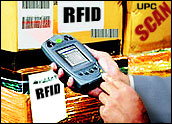
When Wal-Mart imposed its seemingly — to the suppliers at least — draconian RFID mandate, it also held out the future promise that the cost of the technology would someday be quite affordable, perhaps as low as 5 US cents per tag. That day hasn’t come — at least not yet.
Currently, the cost of passive tags range from as low as 11 cents to as much as $40 per tag, according to industry figures. These prices are based on the trade off between quality and read range. The longest read range for passive tags is now 40 feet; the shortest is actual physical contact.
It can be difficult to pinpoint how much prices have dropped given the wide variety of products on the market and the ongoing introduction of new products. Anecdotally, the industry consensus is that product prices are in fact dropping.
Passive Tag Commoditization?
Will price points ever reach 5 cents per tag? The ingredients are certainly there, although there is plenty of wiggle room for error — Wal-Mart’s own price projections serving as Exhibit A.
Proponents, though, point to a convergence of factors that suggest passive RFID technology may be on the brink of commoditization. The major standards disputes in this area have been decided.
“There is support now for a broad range of protocols at the tag level as well as for different devices and different methodologies for reporting,” Martyn Mallick, Sybase iAnywhere’s director of RFID technologies, told CRM Buyer.
The technology is getting better as it gets cheaper, according to Tim Harvie, CEO of Fluensee, a provider of RFID-enabled asset tracking and supply chain management applications. “A 50 cent tag with nothing but adhesive on the back doesn’t do anything for anybody,” Harvie told CRM Buyer.
For instance, mid level RFID tags priced between $5 to $7 were highlighted at RFID World in Dallas this week, he said, adding that he expects to see them come to market in the near future.
These passive tags will fill an important gap in the market — between the very low end and the very high end, Harvie suggested. “While a company may not be able to afford to put $60 tags on assets, it can afford $5 tags.”
The new tech development is key, because of the advanced functionality it delivers. “These are battery assisted tags with new antenna that exceed the short read ranges associated with the cheaper, passive tag technology.” Once they hit the market they will add pressure to related technology price points and accelerate adoption, he claimed.
Wider Adoption
Indeed, it is wider adoption that many in the industry believe will be key, ultimately to cheaper technology.
Innovation can be expected to make incremental improvements in costs, Alan Melling, senior director of business development at Motorola’s Enterprise Mobility Division, told CRM Buyer. “But it is market adoption and additional volume that will play a bigger role in the price drop in the long run,” he predicted.
“Prices have dropped below where they were two years ago, based on increased tech innovation. But to drop further that will require more volume,” Melling pointed out. “And the market is growing a moderate pace.”
It is here that opinions diverge as to whether RFID price points can drop any further. Harvie, for instance, believes that the advanced functionality and lower cost RFID tags will drive adoption, and hence volumes.
Why Bother?
To be sure, there are some RFID projects where price is at best a secondary consideration, although usually these entail active technology. “Price is not everything,” Melling said. “There are some tags where it is important that the price falls if the technology is to be adopted and other tags where performance is key and the price does not matter to companies that use them.”
Prices are already fairly cheap, especially at the case level, Martin Brewer, director of new product development at Wavelink, a provider of mobile application development and mobile infrastructure management software solutions, told CRM Buyer. “What companies need to do is ignore the cost for a moment and see what the benefit could be from implementing it.”
Brewer sheepishly agreed that RFID return can be difficult to quantify. “You can spend a lot on RFID before it makes sense. Sometimes, it turns out you don’t have to.” For instance, instead of using RFID to identify the inefficiencies in a supply chain, a series of time measurements — using a simplified example, when goods arrive from the warehouse to the store shelves — could accomplish roughly the same goal.
“I think the message companies need to take home is that the price of the tag is a factor — but not the only factor,” Brewer declared. “They also need to start thinking that if price is in fact a significant part of their RFID business case, at what price point does the tag need to be.”
Identifying that number now is more important than ever since it appears to be a moving target in the market.













































Social CRM
See all Social CRM